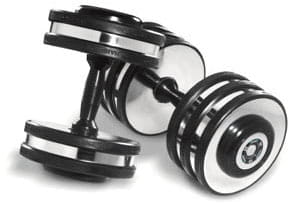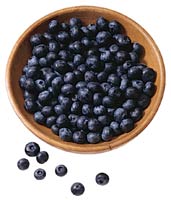Are you a cardio junkie? Everyone seems to think that "cardio" is the best way to get in shape and lose body fat. I'm going to show you with this article why I disagree!
It is quite common to hear fitness pros, doctors, and other health professionals prescribe low to moderate intensity aerobic training (cardio) to people who are trying to prevent heart disease or lose weight. Most often, the recommendations go something like this:
"Perform 30-60 minutes of steady pace cardio 3-5 times/week maintaining your heart rate at a moderate level"
Before you just give in to this popular belief and become the “hamster on the wheel” doing endless hours of boring cardio exercise, I’d like you to consider some recent scientific research that indicates that steady pace endurance cardio work may not be all it’s cracked up to be.
First, realize that our bodies are designed to perform physical activity in bursts of exertion followed by recovery, or stop-and-go movement instead of steady state movement. Recent research is suggesting that "physical variability" is one of THE most important aspects to consider in your training.
This tendency can be seen throughout nature as most animals tend to demonstrate "stop-and-go" motion instead of steady state motion. In fact, humans are the only creatures in nature that attempt to do “endurance” type physical activities such as running long distances at the exact same speed the whole time.
This tendency can be seen throughout nature as most animals tend to demonstrate "stop-and-go" motion instead of steady state motion. In fact, humans are the only creatures in nature that attempt to do “endurance” type physical activities such as running long distances at the exact same speed the whole time.
Most competitive sports (with the exception of endurance running or cycling) are also based on stop-and-go movement or short bursts of exertion followed by recovery.
To examine an example of the different effects of endurance or steady state training versus stop-and-go training, consider the physiques of marathoners versus sprinters. Most sprinters carry a physique that is very lean, muscular, and powerful looking, while the typical dedicated marathoner is more often emaciated and sickly looking. Now which would you rather resemble?
Another factor to keep in mind regarding the benefits of physical variability is the internal effect of various forms of exercise on our body. Scientists have known that excessive steady state endurance exercise (different for everyone, but sometimes defined as greater than 60 minutes per session most days of the week) increases free radical production in the body, can degenerate joints, reduces immune function, causes muscle wasting, and can cause a pro-inflammatory response in the body that can potentially lead to chronic diseases.
Highly variable cyclic training
Highly variable cyclic training
On the other hand, highly variable cyclic training has been linked to increased antioxidant production in the body and an anti-inflammatory response, a more efficient nitric oxide response (which can encourage a healthy cardiovascular system), and an increased metabolic rate response (which can assist with weight loss). Furthermore, steady state endurance training only trains the heart at one specific heart rate range and doesn’t train it to respond to various every day stressors.
On the other hand, highly variable cyclic training teaches the heart to respond to and recover from a variety of demands making it less likely to fail when you need it. Think about it this way... Exercise that trains your heart to rapidly increase and rapidly decrease will make your heart more capable of handling everyday stress. Stress can cause your blood pressure and heart rate to increase rapidly. Steady state jogging and other endurance training does not train your heart to be able to handle rapid changes in heart rate or blood pressure.
The important aspect of variable cyclic training that makes it superior over steady state cardio exercise is the recovery period in between bursts of exertion. That recovery period is crucially important for the body to elicit a healthy response to an exercise stimulus. Another benefit of variable cyclic training is that it is much more interesting and has lower drop-out rates than long boring steady state cardio programs.
To summarize, some of the potential benefits of variable cyclic training compared to steady state endurance training are as follows: improved cardiovascular health, increased anti-oxidant protection, improved immune function, reduced risk for joint wear and tear, increased muscularity (versus decreased muscularity with endurance training), increased residual metabolic rate following exercise, and an increased capacity for the heart to handle life’s every day stressors.
Sports Workouts and Sprinting
The important aspect of variable cyclic training that makes it superior over steady state cardio exercise is the recovery period in between bursts of exertion. That recovery period is crucially important for the body to elicit a healthy response to an exercise stimulus. Another benefit of variable cyclic training is that it is much more interesting and has lower drop-out rates than long boring steady state cardio programs.
To summarize, some of the potential benefits of variable cyclic training compared to steady state endurance training are as follows: improved cardiovascular health, increased anti-oxidant protection, improved immune function, reduced risk for joint wear and tear, increased muscularity (versus decreased muscularity with endurance training), increased residual metabolic rate following exercise, and an increased capacity for the heart to handle life’s every day stressors.
Sports Workouts and Sprinting
There are many ways you can reap the benefits of stop-and-go or variable intensity physical training. Most competitive sports such as football, basketball, volleyball, racquetball, tennis, hockey, baseball, etc. are naturally comprised of highly variable stop-and-go motion which trains the heart through a MUCH wider heart rate range compared to just steady walking or jogging.
Doing swimming workouts in a variable intensity fashion may also be more beneficial than just swimming for a long duration at the same speed. Same goes for bicycling -- that is why mountain biking, which involves extreme ups and downs at various intensity levels may also be more beneficial than just a long flat steady pace bike ride.
One of the absolute most effective forms of variable intensity training to really reduce body fat and bring out serious muscular definition is performing wind sprints. Wind sprints can be done by sprinting at near max speed for 10-30 seconds, and then taking 60 seconds to walk for recovery before your next sprint. 6-12 total sprint intervals is usually a very challenging workout for most people.
In addition, weight training naturally incorporates short bursts of exertion followed by recovery periods. High intensity interval training (varying between high and low intensity intervals on any piece of cardio equipment) is yet another training method that utilizes exertion and recovery periods. For example, an interval training session on the treadmill could look something like this:
Warm-up for 3-4 minutes at a fast walk or light jog
Warm-up for 3-4 minutes at a fast walk or light jog
Interval 1 - run at 8.0 mi/hr for 1 minute
Interval 2 - walk at 4.0 mi/hr for 1.5 minutes
Interval 3 - run at 10.0 mi/hr for 1 minute
Interval 4 - walk at 4.0 mi/hr for 1.5 minutes
Repeat those 4 intervals 4 times for a very intense 20-minute workout.
Interval 2 - walk at 4.0 mi/hr for 1.5 minutes
Interval 3 - run at 10.0 mi/hr for 1 minute
Interval 4 - walk at 4.0 mi/hr for 1.5 minutes
Repeat those 4 intervals 4 times for a very intense 20-minute workout.
Also, don't overlook other great ways to incorporate variable intensity cardio training by using a jump rope, a rowing machine, stairs running, or even outdoor hill sprints.
The take-away message from this article is to try to train your body at highly variable intensity rates for the majority of your workouts to get the most beneficial response in terms of heart health, fat loss, and muscle maintenance.
The take-away message from this article is to try to train your body at highly variable intensity rates for the majority of your workouts to get the most beneficial response in terms of heart health, fat loss, and muscle maintenance.
Source: Mike Geary – Certified Personal Trainer, Certified Nutrition Specialist



